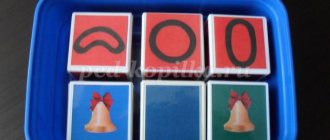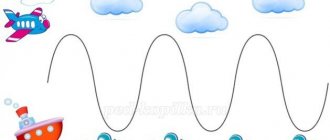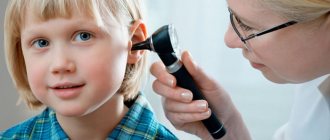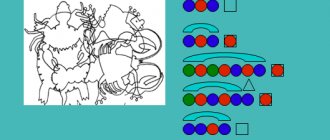Progress of the lesson
Educator. Children, today we will talk about toys, what they are and what you can do with them. We will speak loudly, clearly, pronouncing every word clearly. (Takes the ball and shows it to the children.) What is this? Children. Ball. Educator. Tell me two words about the ball, what it is like. Children. The ball is beautiful; the ball is big; the ball is red. Educator. Tell me, Seryozha, how many words Lyuba said about the ball. Seryozha. Lyuba said two words about the ball. The first word is “ball”, the second is “red”. Teacher (drops the ball on the floor). Children, say two more words about the ball. Educator. Tell me, Galya, how many words did Gena say about the ball? Galya. Gena said two words about the ball. The first word is “ball”, the second is “rolled”. Teacher (places the doll on a chair). Say two words about the doll. Sveta. Beautiful doll. I said two words about the doll. The first is beautiful,” the second is “a doll.” Teacher (puts a flag on the table). Now say two words about the checkbox. (Children also sorted these sentences into words and determined their place in the sentences). Teacher (approaches the toy kitten, presses the button - the kitten makes a squeak). Say two words about the kitten. (These sentences are also analyzed word by word.) Educator. Valya, come and press the button on the dog. Tell me a two-word sentence about the dog. Valya. The dog barks. I said two words: the first is “dog”, the second is “barks”. Educator. Today we talked about toys in two words. At school they will say this: “We learned to make two-word sentences about toys. We noticed which is the first and which is the second word in a sentence.” Who knows the riddles about these toys? Seryozha. They beat him, but he doesn't cry. It just jumps higher and higher. (Ball.) Gene. I bring it to the holiday, I walk and sing with it. (Flag.) Marina. He is friends with the owner and looks after the house. He barks at strangers and doesn’t let them into the house. Children. Dog.
Speech therapy lesson on the topic “Speech. Offer."
Summary of a speech therapy lesson for 1st grade students with OHP
Subject:
Speech. Offer. Word. Consolidation.
Target:
consolidate students' knowledge on the topic.
Tasks:
Educational:
consolidate students' knowledge on the topic “Speech. Offer. Word".
Educational:
- develop the ability to compose sentences from a picture, as well as to compose sentences from words given in the initial form.
- develop the ability to answer in complete sentences.
- develop auditory attention, the ability to grasp intonation completeness, differentiate a set of words and sentences by ear.
- activate the ability to distinguish between interrogative, exclamatory and narrative intonation;
- work on improving the intonation side of speech;
- develop fine motor skills.
Educational:
Cultivate accuracy and the ability to organize one’s own activities.
Equipment:
mirrors; individual story pictures; numbers 3, 5, 6 for each child; individual strips for drawing up sentence diagrams; individual cards with a dot; incentive stickers.
Progress of the lesson
- Organizational moment (1 min).
The speech therapist greets the children. Clarifies the purpose of mirrors.
- Articulation gymnastics (3 min).
The exercises are selected in accordance with the phonetic impairments of the group (the majority have impaired sound [r]).
Lip exercises:
“Smile”, “Tube”, “Window”, “Smile - tube - window” (5 times).
Exercises for the tongue:
“Let’s brush the upper teeth”, “Sail”, “Painter”, “Fungus”.
Children perform each exercise 3 times.
- Main part (8 min).
A) Review conversation.
- Let's remember what our speech is? /Conversation, question, story – this is our speech/.
-What does our speech consist of? /Our speech consists of sentences/.
- How are the sentences in the story? /The sentences in the story are in order/.
- How are they related to each other in the story? /They are interconnected in meaning/.
-What do sentences consist of? /Sentences consist of words/.
— How are the words connected in a sentence? /The words in the sentence are related in meaning/.
— How do they stand in a sentence? /They appear in order in the sentence/.
— What signs can appear at the end of a sentence? /At the end of a sentence there may be a period, a question mark or an exclamation mark/.
— When do we put a question mark at the end of a sentence? /When we ask/.
— When do we put an exclamation point? /When we rejoice/.
B) Dividing the story into sentences.
The speech therapist gives the children cards with a dot.
- Guys, I’ll read the text to you now, and you listen to it carefully.
The speech therapist reads the story without pauses.
It was deep autumn. The forest looked gloomy and inhospitable. It rained almost every day. Low clouds crawled over the treetops. The cranes and storks have long since flown south. The forest was empty, dull and very quiet.
— Did you like the story? Was everything clear to you? Did I read it well? /No/.
- What was wrong? What did I do wrong? /There were no pauses/.
- Yes. Now listen carefully to the story again and raise the period at the end of each sentence. Do you understand the task? /Yes/.
- How do we determine the end of a sentence by ear? What will we listen to? /There will be a pause and the voice will lower./.
- Fine. We listen carefully and raise the period at the end of each sentence.
The speech therapist reads the story.
Children complete the task.
The speech therapist gives the children cards with numbers.
- Well done. Has anyone counted how many sentences are in the story? /No/.
“Then I’ll read the story again, and you count how many sentences there are in it and show the number.”
Re-reading the story.
Children show a number indicating the number of sentences in the story.
- What were we listening to now? /We listened to the story/.
-What was this story about? /About autumn./
- Right. What does every story necessarily have that ours doesn’t? /Title/.
- Let's come up with a name for it together. /Autumn/.
- Fine. Well done. What does the story consist of? /The story consists of sentences/.
- How are the sentences in the story? /The sentences in the story are in order/.
- How are they related to each other in the story? /They are interconnected in meaning/.
— How to determine the boundaries of the proposal? /There will be a pause and the voice will lower./.
- Finger gymnastics (2 min).
- Now let's relax and train our fingers!
“Hooks”, “Fists”, “Shake off droplets of water”, “Fingers say hello”, “Hedgehog”, “Castle”.
- Main part (continued) (11 min).
B) Riddle. Work in a notebook. Drawing up diagrams.
1. – Okay, well done! Let's open the notebooks, but we won't write anything in them yet!
- Listen and guess the riddle.
Yellow leaves are flying.
They rustle underfoot.
The sun is no longer hot.
When does all this happen? /Autumn/
2. – Now listen again and remember the first sentence.
The speech therapist reads a riddle.
- Who remembered? /Yellow leaves are flying/.
- Yes, we’ll draw a diagram for this proposal.
Children draw a diagram in notebooks, a speech therapist draws a diagram on the board.
- Where do we start drawing? /From the corner/.
- What does corner mean? /The beginning of a sentence, we write with a capital letter/.
- How do we separate words in a sentence? /We separate words with a space/.
— How many words are there in a sentence? /There are three words in the sentence/.
- Yes, how are words written in a sentence? /Words in a sentence are written separately/.
- Right. Therefore, how will we draw them on the diagram? /We will draw with a space/.
- What does the dot mean? /The period means the end of the sentence/.
- And the arrow? /
The arrow indicates a decrease in voice/.
- Fine. What will be the first word in the sentence? /Leaves/.
- What's the last word? /Flying/.
- And the second word? /Yellow/.
3. Independent work.
- Well done. I’ll read the riddle again, and now you remember the second sentence.
The speech therapist reads a riddle.
- Who remembered? /They rustle underfoot/.
- Okay, now draw a diagram of this sentence yourself.
Children complete the task.
4. – Listen to the fourth sentence. What does it sound like? /With a question/.
- What's happening to my voice? /Voice rises/.
- Yes. Now everyone take turns saying this sentence. /When does all this happen?/.
- I'm asking? /Yes/.
- What sign should we put at the end? /Place a question mark/.
- Draw a diagram of this proposal.
Children draw a diagram on their own.
- Now let's say the same sentence so that our voice lowers so that it becomes declarative. /When all this happens/.
- Fine. And now to raise our voice, let’s say joyfully. /When all this happens!/
- Physical exercise (2 min).
“Now let’s rest a little.” Everyone got up.
Game “If it’s a word, we’ll clap, if it’s a sentence, we’ll stomp.”
- If you hear a word, clap, and if you hear a sentence, stomp.
Day. A light rain began to fall. Month. Autumn. We are going to walk. The sun is shining. Mushrooms. You like autumn? I like summer. Sheet. What a nice weather! Clouds. Many clouds appeared in the sky.
- Let's sit down. How did you determine where the word is and where the sentence is? /There are many words in the sentence/.
7. Main part (continued) (11 min).
D) Did. game “Is this a proposal?”
—
Can what I say be called a proposal? Does it sound nice? /No/.
- Make it sound beautiful. Boy, open the door.
Sit, titmouse, on a branch.
Pear, grandmother, granddaughter, give.
Vitya, mow, grass, rabbits, for.
Petya, buy, ball, red, mom.
Girl, put a book, table, on.
Children make sentences correctly.
-Guys, why can’t what I called be called a proposal? /The words there are not connected in meaning or order/.
D) Didactic game “Make a sentence.”
- Now come up with a sentence containing 2 words.
Children come up with suggestions.
- Summary of the lesson (2 min).
- What did we do in class today?
— What did we remember in class today?
— What did you like about the lesson?
The speech therapist evaluates the performance of each student and distributes incentive stickers.
MAGAZINE Preschooler.RF
Summary of a speech therapy lesson on teaching literacy in a preparatory school group “A sentence consisting of three or more words with a direct object” using the Logomer software-didactic complexprepared by teacher - speech therapist N.N. Fedichkina. Kirishi 2021 Municipal autonomous preschool educational institution "Kindergarten No. 16 for health purposes"
Goal: to develop skills in composing sentences of three or more words.
Tasks:
Educational: teach children to correctly form sentences of three or more words; teach how to distribute proposals; teach how to make sentences using a model; learn how to make your own sentences.
Developmental: skills of grammatical design of sentences and their distribution by adding definitions; develop attention and logical thinking.
Educational: develop skills of organized behavior.
Progress of the lesson:
I Organizational moment.
Articulation gymnastics (Logomer. Set of exercises.)
II Subject message.
— We worked with sentences that consisted of only two words. But a sentence can have three, four, five or more words. Today we will learn how to make sentences of three or more words.
III Study of the topic.
1. “Making three-word sentences based on plot pictures”.
Logomer. Image constructor.
- Look carefully at the picture. (Slide No. 7)
- Who is this? (Girl). What is she doing? (is reading). Let's make a sentence - The girl is reading.
- How many words are in our sentence? (Two) Name the first word: who? - girl - the word is a living object. Name the second word: what is the girl doing? – reads – the second word-word-action.
— What is the girl reading? (Book, newspaper).
Girl reading a book (newspaper)
- What word was added to the sentence? Book (newspaper). How many words are there in the sentence? (Three). Let's outline our proposal.
The following pictures are displayed next. (Slide No. 1) The work is carried out in a similar way.
2. “Making three-word sentences based on two object pictures”.
- Look carefully at the pictures. (Slide No. 8) We see two subject pictures: a boy and a fish).
- Let's try to make a sentence by matching the picture with a word that denotes an action:
The boy catches fish.
— Let’s draw up a diagram of our proposal.
The following pictures are displayed next. (Slide No. 9) The work is carried out in a similar way.
3. “Make three-word sentences with each child”.
Each child is given one story picture and is asked to independently compose a three-word sentence based on it.
4. Physical education minute:
Logomer. A set of exercises for the development of motor skills.
5. “Complicating proposals. Making sentences from four words with adding a definition" .
- Now let's complicate these sentences. (Slide No. 10) For example: The bunny is gnawing on a carrot. Carrots (cabbage,...) what? (Delicious) or: What kind of bunny? Fluffy (small,...), etc..
— Let’s draw up a diagram of our proposal.
The following pictures are displayed next. (Slide No. 11) The work is carried out in a similar way.
6. Exercise “Assemble a sentence from words .
- And now I will tell you the words, and you listen to them carefully and collect sentences from them.
Example: Ball, Tanya, catch, big. – Tanya catches a big ball.
- Sweater, mom, knit, beautiful. (Mom knitted a beautiful sweater)
- Fish, fishermen, catch, big. (The fishermen caught a big fish)
- The book, Katya, is interesting to read. (Katya is reading an interesting book)
- Dragonfly, Rita, see, it’s big. (Rita saw a big dragonfly)
— Bun, Vova, buy it, delicious. (Vova bought a delicious bun)
- Children draw with pencils, colored ones. (Children draw with colored pencils)
— Tree, storm, broken, old. (The storm broke the old tree).
IV. Result:
- You did great today! We did very well.
- What new did you learn? What did you like most?
| Next > |
Working with deformed sentences. Editing, grammatical formatting of sentences
Methodological goal: Using ICT as a way to optimize the process of correcting oral and written speech.
Target:
development of coherent speech in speech therapy classes using ICT.
Tasks:
Corrective:
- develop the ability to find and correct speech (logical) errors in sentences;
- develop the ability to make sentences based on a plot picture using supporting questions;
- develop the ability to compose sentences, observing the correct word order;
- teach children to use sentences of various syntactic structures in speech;
- learn to compose sentences with homogeneous members;
— improve the grammatical structure of students’ speech;
— clarify and enrich vocabulary on the topic “Spring”;
Educational:
- develop the ability to correctly express your thoughts;
- develop intonation expressiveness of speech and clear sound pronunciation;
— develop the ability to formulate answers to questions;
- develop speech motor skills and visual perception;
- develop higher mental processes: attention, memory, logical thinking, spatio-temporal ideas;
Educational:
- cultivate a desire to actively work in class;
- develop self-control and adequate self-esteem.
Propaedeutic work:
— teach tongue twisters about spring with students;
— train children in editing deformed sentences.
In my opinion, the set goal and objectives of the speech therapy session were achieved. The students completed the expected tasks.
During the lesson, I emphasized exercise and selected tasks to consolidate work with deformed sentences.
I believe that it is impossible to imagine a modern occupation without the use of information and communication technologies. In my opinion, ICT improves the quality and effectiveness of the educational and correctional process. In this regard, I determined for my work the feasibility of using ICT in speech therapy classes, as a way to optimize the process of correcting written and oral speech. I believe that the use of a variety of non-traditional methods and techniques in correctional work prevents children from becoming tired, supports cognitive activity, and increases the effectiveness of speech therapy work in general. (The introduction of computer technologies today is a new stage in the educational process, therefore I actively include the use of ICT in my practice in the process). Experience shows that the use of PCs in speech therapy classes allows one to monitor the degree of assimilation of the material presented at the final stage of consolidating the acquired knowledge. In addition, the program helps develop memory and attention, which are necessary for children to be successful in elementary school.



